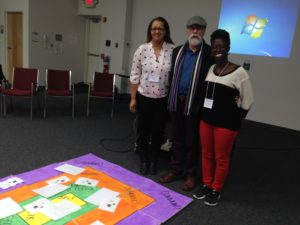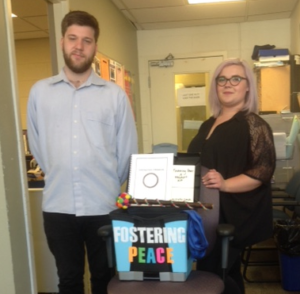 Rick Kelly, a professor in the Child and Youth Care (CYC) program at George Brown College (Toronto) and an IIRP alumnus, with students Sewsen Ikbu (left) and Amy Taylor at the 19th IIRP World Conference.
Rick Kelly, a professor in the Child and Youth Care (CYC) program at George Brown College (Toronto) and an IIRP alumnus, with students Sewsen Ikbu (left) and Amy Taylor at the 19th IIRP World Conference.
Rick Kelly, a professor in the Child and Youth Care (CYC) program at George Brown College (Toronto), has created a hub for restorative practices to support practical learning and social innovation by students at his college. Both students and the local community are benefitting from the hub, which is introducing restorative concepts and solutions to schools and neighborhoods.
CYC is a three-year diploma that prepares students to work effectively with at-risk youth in alternative education, shelters, residential facilities, substance abuse and other related programs. The hub provides unique opportunities for third-year students to develop projects in real work settings and obtain in-depth support from their professors as well as fellow students.
Kelly earned a Master of Science in Restorative Practices from the International Institute for Restorative Practices (IIRP) Graduate School in 2015. He has conducted trainings and incorporated restorative practices into his work for 15 years. The hub has allowed him to branch out and dovetail his passion for spreading restorative skills right along with his college teaching.
“My mission is to demonstrate how ‘best practice’ work with children, youth, families and communities is by nature restorative, and to integrate these beliefs and practices into teaching, the curriculum and for student engagement at the college level,” Kelly explains.
In 2015, Kelly and two of his students presented at the IIRP World Conference on their internship in Jamaican prisons and youth facilities and other hub projects. Kelly will again bring students to present at the IIRP’s 21st World Conference on their groundbreaking and wide-ranging work.
Hub student Symone Walters focused on developing a restorative peacemaking hub in her own community to address social conditions that resulted in the tragic shooting death of her 15-year-old son in 2013 and three other youth in the neighborhood the same year.
“I realized there’s no place for these youth to go to hang out safely,” says Walters. “Due to a lack of resources and programming, an entire community is stricken with a lot of negative things.”
Walters has been meeting with community groups, community members and government officials and agencies to develop support for her idea.
Adds Walters, “When we look at restorative, we look at the history of community members, what has created their thought processes, and why they act and behave the way they do. If we understand that, we can help them move forward.”
In another hub project, students piloted a family resource center that provided daycare for children of student-parents and housed a clothing, book and baby toy swap.
Hub students placed in a local elementary school presented restorative concepts to children in the fourth, fifth and sixth grades as a proactive community-building process, so that when conflicts arose the children would know how to respond.
 George Brown students Karoline Medeiros and Daniel Entwistle pose with the restorative resource kit they developed.
George Brown students Karoline Medeiros and Daniel Entwistle pose with the restorative resource kit they developed.
“The hub allowed the time to really explore restorative practices in a new way, through peacemaking and leadership,” says hub student Karoline Medeiros. “We used drama, art and talking circles to present various situations and explore questions like, ‘What does harm look like and feel like?’ and ‘If you experience harm, how would you want to approach that?’”
Building upon their experience in the school, Medeiros and colleague Daniel Entwistle created “Fostering Peace: A Mindset Kit,” which they entered in a “Social Innovation Challenge,” a competition to find the best new business ideas, organized by the United Church of Canada. The kit included a manual about teaching restorative concepts to schoolchildren, plus activity cards and all the materials to make a “raccoon circle” – a special rope that can be used to play dozens of teambuilding games. Medeiros and Entwistle plan to build elements of the kit into a mobile app that teachers can use in their classrooms.
Kelly, Walters, Medeiros and Entwistle will present “Changing Mindsets: Repair Is in the Building” at “Restoring Community,” the 21st IIRP World Conference, in Bethlehem, Pennsylvania, October 2016.

